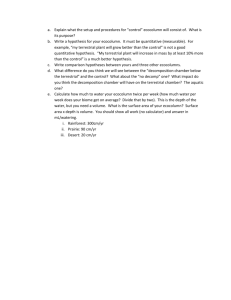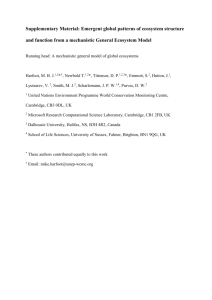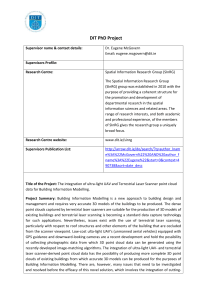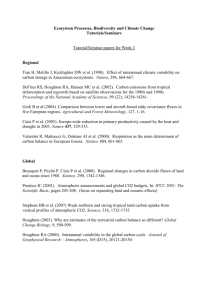EnvCalc_Output_Variable_Description
advertisement
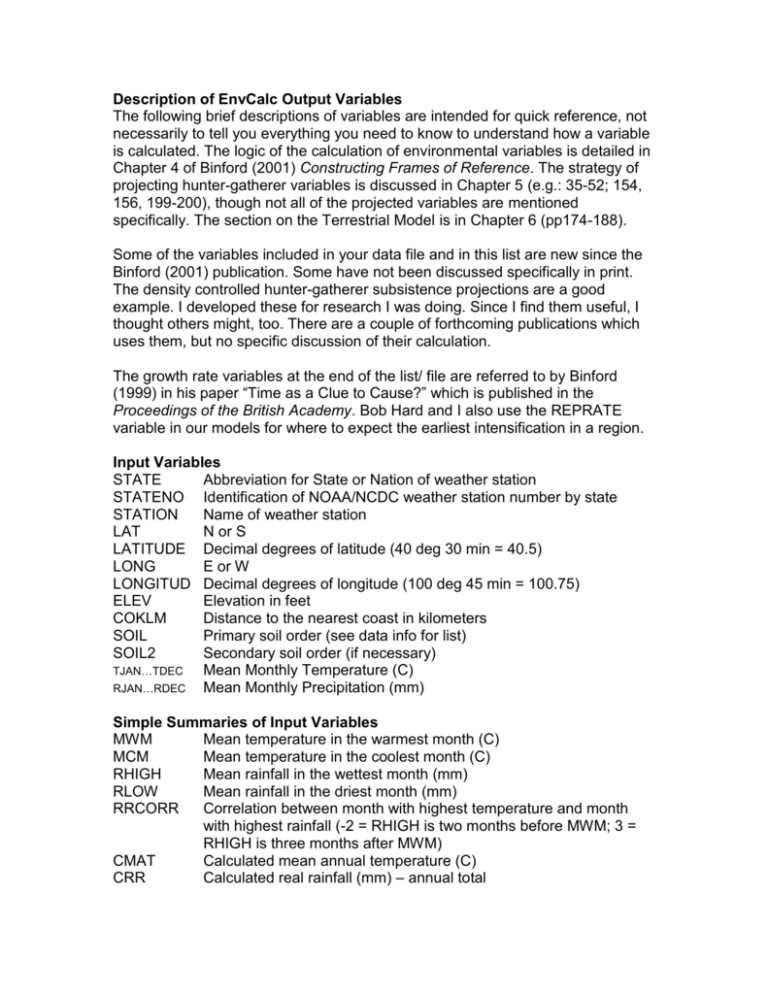
Description of EnvCalc Output Variables The following brief descriptions of variables are intended for quick reference, not necessarily to tell you everything you need to know to understand how a variable is calculated. The logic of the calculation of environmental variables is detailed in Chapter 4 of Binford (2001) Constructing Frames of Reference. The strategy of projecting hunter-gatherer variables is discussed in Chapter 5 (e.g.: 35-52; 154, 156, 199-200), though not all of the projected variables are mentioned specifically. The section on the Terrestrial Model is in Chapter 6 (pp174-188). Some of the variables included in your data file and in this list are new since the Binford (2001) publication. Some have not been discussed specifically in print. The density controlled hunter-gatherer subsistence projections are a good example. I developed these for research I was doing. Since I find them useful, I thought others might, too. There are a couple of forthcoming publications which uses them, but no specific discussion of their calculation. The growth rate variables at the end of the list/ file are referred to by Binford (1999) in his paper “Time as a Clue to Cause?” which is published in the Proceedings of the British Academy. Bob Hard and I also use the REPRATE variable in our models for where to expect the earliest intensification in a region. Input Variables STATE Abbreviation for State or Nation of weather station STATENO Identification of NOAA/NCDC weather station number by state STATION Name of weather station LAT N or S LATITUDE Decimal degrees of latitude (40 deg 30 min = 40.5) LONG E or W LONGITUD Decimal degrees of longitude (100 deg 45 min = 100.75) ELEV Elevation in feet COKLM Distance to the nearest coast in kilometers SOIL Primary soil order (see data info for list) SOIL2 Secondary soil order (if necessary) TJAN…TDEC Mean Monthly Temperature (C) RJAN…RDEC Mean Monthly Precipitation (mm) Simple Summaries of Input Variables MWM Mean temperature in the warmest month (C) MCM Mean temperature in the coolest month (C) RHIGH Mean rainfall in the wettest month (mm) RLOW Mean rainfall in the driest month (mm) RRCORR Correlation between month with highest temperature and month with highest rainfall (-2 = RHIGH is two months before MWM; 3 = RHIGH is three months after MWM) CMAT Calculated mean annual temperature (C) CRR Calculated real rainfall (mm) – annual total WSTORAGE Amount of water which can be stored in the soil (mm) Calculations of Water Balance and Derived Variables, Including those Relating to Plant Productivity ET Effective Temperature (following Bailey) [14 is the mean value for the world-- tropics range up to 26, polar regions down to 8 or so] PET Potential evapotranspiration (mm) – amount of water which could be evaporated by incoming solar radiation over a year SNOWAC Annual snow accumulation (mm of water) WRET Annual average water retention in the soil (mm) PERWRET Percent of months in the growing season with water retention in the soil AE Actual evapotranspiration (mm) – amount of water which is evaporated given both annual incoming solar radiation and precipitation amounts RUNOFF Annual amount of runoff (mm) - water in excess of the amount which can be stored in the soil or evaporated WATD Water deficit (mm) – difference between the amount of water which could be evaporated and stored in the soil and the water which is available MI Moisture index – continuous scale negative values indicate drier settings, positive values indicate wetter settings (following Thornwaite & Mather 1955) BT Biotemperature (C) – measure of central tendency of temperature which divides the sum of mean temperatures for months with mean > 0 by 12 (following Holdridge 1947) GROWC Count of months in the growing season WLTGRC Number of growing season months with little enough rainfall plants will wilt WATDGRC Number of growing season months with a water deficit WATRGRC Number of growing season months in which water is retained in the soil RUNGRC Number of growing season months with sufficient precipitation to produce runoff PGROW Plant growth potential – scale is 0-36 with 36 indicating settings with sufficient solar radiation and rainfall for plants to grow well in every month (values for each month range from 0-3 with – 0 indicates insufficient solar radiation, 1 indicates plants past wilting point, 2 indicates months with a water deficit, 3 indicates months with enough of both solar radiation and water in the soil) SDTEMP Standard deviation of the monthly temperature values CVTEMP Coefficient of variation of the monthly temperature values SDRAIN Standard deviation of the monthly precipitation values CVRAIN Coefficient of variation of the monthly precipitation values RRCORR2 Adjusted correlation between month of peak temperature and month of peak rainfall [=RRCORR +4.5 such that when peak temperature and peak rainfall are in same month, RRCORR2=4.6] RRCORR3 Collapsed adjusted correlation between month of peak temperature and month of peak rainfall [If GROWC=12 then RRCORR3= 4.6; else RRCORR3=RRCORR2] SEASON Ordinal code of the season of peak rainfall (1=spring, 2=summer, 3=autumn, 4=winter) calculated from values of RRCORR BIO5 Standing biomass of the plant community (g/m2) BAR5 Biomass accumulation ratio – new cells of standing biomass added each year – low values indicate deserts, grasslands, high values indicate forests NAGP Net above ground productivity (g/m2/yr) – new cells of above ground plant material (stems, leaves; not roots) added each year TEMP Temperateness – low values indicate highly seasonal climates; high values indicate climates with less seasonal variability HIRX Rainfall Index – [PET/CRR] (following Holdridge 1959; similar to Holdridge 1947) values < 1 indicate environments which can support forests, values > 1 indicate arid plant communities RRANGE Range (mm) of mean monthly precipitation values TRANGE Range (C) of mean monthly temperature values REVEN Evenness of mean monthly precipitation values MRAIN Meanness of mean monthly precipitation values MTEMP Meanness of mean monthly temperature values PTOAE Ratio of Potential evapotranspiration to Actual evapotranspiration (PET/AE) PTOWATD Ratio of Potential evapotranspiration to Water deficit (PET/WATD) PTORUN Ratio of Potential evapotranspiration to Runoff (PET/RUNOFF) PTOWATR Ratio of Potential evapotranspiration to Water retention in the soil (PET/WRET) PERWLTG Percentage of months in the growing season with little enough water retention that plants will wilt PERWDEF Percentage of months in the growing season with a water deficit Scale = 0-1 DEFPER Percentage of months in the growing season with a water deficit Scale = 0-100 (DEFPER=100*PERWDEF) AVWAT Ordinal scale of water availability (low = drier; high = wetter) Variables which summarize environmental characteristics CLIM Ordinal scale of climate (low = colder; high= warmer) CLASS Wet/ Dry classification MEDSTAB Mediterranean stability – highest values indicate dry regions with winter rainfall SUCSTAB Successional stability – highest values indicate regions where summer thunderstorms could ignite fires SUCSTAB2 Successional stability 2 – revised version of SUCSTAB: highest values indicate regions likely to have a fire maintained landscape – hot dry summers with intermittent thunderstorms; includes terms monitoring fuel availability WACCESS Water stored in the soil which is accessible to plants Log variables L+Variable Name: Log10 of (Variable Name) : [LLAT, LBIO5, LNAGP, LMEANELV, LET, LPET, LAE, LBT, LTRANGE, LCMAT, LMCM, LMWM, LMTEMP, LCVTEMP, LCRR, LREVEN, LRRCORR2, LRRCORR3, LRRANGE, LDEFPER, LPERWDEF, LPTOAE, LRUNOFF, LRHIGH, LRLOW, LCOKLM, LPERWLTG, LSNOWAC, LWACCESS, LPTORUN, LRUNGRC, LWRET, LWLTGRC, LBAR5, LMRAIN, LWATD, LCVRAIN, LPTOWATD, LPTOWATR, LWATRGRC, LHIRX, LSSTAB2] Projected Ungulate Biomass EXPREY Expected prey biomass g/m2 – ungulate biomass projected from regression equation using environmental variables to calculate value run on 104 cases with recorded ungulate biomass LEXPREY Log10 of EXPREY Hunter-Gatherer Projections (Subsistence and Density) WSUM Sum of the initial projections of dependence on hunting, gathering and fishing – the closer this value is to 100, the less the values of WHUNTP, WGATHP, WFISHP were adjusted through iteration (used to assess when to be more cautious about projections – my rule of thumb is that if this value is < 80 or > 120, I’m more cautious about using the HG projected subsistence) WHUNTP Projected hunter-gatherer dependence on terrestrial animals (% of diet) WGATHP Projected hunter-gatherer dependence on terrestrial plants (% of diet) WFISHP Projected hunter-gatherer dependence on aquatic resources (% of diet) [aquatic resources include fish, shellfish, marine mammals and aquatic birds] SUBSPE Expected subsistence specialty – codes the dominant resource in the diet [1=terrestrial animals; 2=terrestrial plants; 3=aquatic resources] WDEN1 Projected hunter-gatherer population density calculated for all 339 HG cases WDEN2 Projected hunter-gatherer population density calculated for only 142 HG cases in the proportional sample [selected as proportional sample of area of the earth covered by different vegetation types] WDEN Projected hunter-gatherer population density – calculated as average of WDEN1 & WDEN2 Terrestrial Model Variables [See Binford 2001 for discussion of Terrestrial Model] TERMH2 Terrestrial Model Hunting Density: number of people per 100 sq km who could be supported by subsistence on terrestrial animals TERMG2 Terrestrial Model Gathering Density: number of people per 100 sq km who could be supported by subsistence on terrestrial plants TERMD2 Terrestrial Model Density (people per 100 sq km): sum of TERMH2 and TERMG2 TERMHNT2 Terrestrial Model Percent Dependence on Hunting TERMGTH2 Terrestrial Model Percent Dependence on Gathering EDENH22 Portion of projected hunter-gatherer population density which would be supported by hunting terrestrial animals [=WDEN *(TERMHNT2/100)] EDENG22 Portion of projected hunter-gatherer population density which would be supported only by gathering terrestrial plants [=WDEN *(TERMGTHT2/100)] Expected value of population pressure index [WDEN/TERMD2] – TERMD2 is used as a baseline population density that could be supported without cultural aids in a given environmental setting; By dividing projected hunter-gatherer population density by the terrestrial model density, we get a value that tells us how many times higher the expected hunter-gatherer density is than the terrestrial model density. This could be used to indicate the degree of population pressure on the resources (particularly relevant for terrestrial resources – see below). EPHNDX22 Expected value of population pressure index specific to terrestrial animal resources [EDENH22/(TERMH2+.01)] EPGNDX22 Expected value of population pressure index specific to terrestrial plant resources [EDENG22/(TERMG2 +.01)] SUBSPX Terrestrial Model Subsistence Specialty [h=hunting, g=gathering, m=mixed (45-55 percent of each), u=uninhabited (if TERMD2 < .3 persons per 100 sq km)] EPRINDX2 More Hunter-Gatherer Projections (Body mass, area, total population, number of moves, distance moved, group sizes, family size, house sizes & density controlled subsistence dependence) EXWGT2 Projected average weight (kg) of adult males (variable by environmental setting) For the following suite of variables, the equations to project hunter-gatherer organizational variability were calculated on subsets of the 339 case file defined by group mobility pattern [GRPPAT: 1=residentially mobile, 2=fairly sedentary] and subsistence specialty [SUBSP: 1=hunting, 2=gathering, 3=fishing]. EXAREA1 Projected area occupied by hunter-gatherers who are residentially mobile throughout the year. EXAREA2 Projected area occupied by hunter-gatherers whose primary residences are stable during the year. EXTLPOP1 Projected total population of an ethnic group for hunter-gatherers who are residentially mobile throughout the year. EXTLPOP2 Projected total population of an ethnic group for hunter-gatherers whose primary residences are stable during the year. EXNOMOV1 Projected number of moves per year for hunter-gatherers who are residentially mobile throughout the year. EXNOMOV2 Projected number of moves per year for hunter-gatherers whose primary residences are stable during the year. EXDMOV1 Projected distance moved (mi) hunter-gatherers who are residentially mobile throughout the year. EXDMOV2 Projected distance moved (mi) by hunter-gatherers whose primary residences are stable during the year. See Binford 2001 for distinctions between how GRP1, GRP2, GRP3 are measured for GRPPAT 1 vs GRPPAT 2. EXGRP1 HG Projected size of either the smallest autonomous residential unit during a year (GRPPAT =1) or the smallest settlement size in a region (GRPPAT =2) EXGRP2 HG Projected size of either the largest interdependent residential unit during a year (GRPPAT=1) or a mid-range settlement size in a region (GRPPAT =2) EXGRP3 HG Projected size of either the largest periodic aggregation (GRPPAT =1) or the largest settlement size in a region (GRPPAT=2) EXMHS Projected Mean Household Size (persons) for hunter-gatherers EXSZMEAN Projected size of the average house (measured as the diameter of a circle (m) which would have an area equivalent to the mean house area) EXSZ1FAM Projected size of the average single family house for huntergatherers (measured as the diameter of a circle (m) which would have an area equivalent to the mean house area) The following variables are calculated just as WHUNTP, WGATHP, and WFISHP are calculated except that instead of using WDEN as an input variable, these equations control the values of population density. UPHUNTP Unpacked HG (density < 9.09 persons per 100 sq km) percent dependence on hunting (terrestrial animals) UPGATHP Unpacked HG (density < 9.09 persons per 100 sq km) percent dependence on gathering (terrestrial plants) UPFISHP Unpacked HG (density < 9.09 persons per 100 sq km) percent dependence on fishing (aquatic resources) D1PHUNTP Packed HG (density =9.09 persons per 100 sq km) percent dependence on hunting (terrestrial animals) D1PGATHP Packed HG (density =9.09 persons per 100 sq km) percent dependence on gathering (terrestrial plants) D1PFISHP Packed HG (density =9.09 persons per 100 sq km) percent dependence on fishing (aquatic resources) D1HPHUNTP HG density 1.5 times “packing threshold” (density = 13.635 persons/ 100 sq km) percent dependence on hunting (terrestrial animals) D1HPGATHP HG density 1.5 times “packing threshold” (density = 13.635 persons/ 100 sq km) percent dependence on gathering (terrestrial plants) D1HPFISHP HG density 1.5 times “packing threshold” (density = 13.635 persons/ 100 sq km) percent dependence on fishing (aquatic resources) D2PHUNTP HG density 2 times “packing threshold” (density = 18.18 persons/ 100 sq km) percent dependence on hunting (terrestrial animals) D2PGATHP HG density 2 times “packing threshold” (density = 18.18 persons/ 100 sq km) percent dependence on gathering (terrestrial plants) D2PFISHP HG density 2 times “packing threshold” (density = 18.18 persons/ 100 sq km) percent dependence on fishing (aquatic resources) D2HPHUNTP HG density 2.5 times “packing threshold” (density = 22.725 persons/ 100 sq km) percent dependence on hunting (terrestrial animals) D2HPGATHP HG density 2.5 times “packing threshold” (density = 22.725 persons/ 100 sq km) percent dependence on hunting (terrestrial plants) D2HPFISHP HG density 2.5 times “packing threshold” (density = 22.725 persons/ 100 sq km) percent dependence on hunting (aquatic resources) D3PHUNTP HG density 3 times “packing threshold” (density = 27.27 persons/ 100 sq km) percent dependence on hunting (terrestrial animals) D3PGATHP HG density 3 times “packing threshold” (density = 27.27 persons/ 100 sq km) percent dependence on gathering (terrestrial plants) D3PFISHP HG density 3 times “packing threshold” (density = 27.27 persons/ 100 sq km) percent dependence on fishing (aquatic resources) Growth Rate Model Variables The rest of the variables are from an extra program which uses environmental variability to model differences in growth rate – based on terrestrial model density as an indication of abundance and accessibility of resources which is tempered by model with higher pathogen loads where it is warmer and wetter and lower pathogen loads where it is cooler/ dryer (using data accumulated by Bobbi Low) TMREPPOT Terrestrial Model Reproductive Potential (without considering pathogens) REPRATE Reproductive Rate (factoring pathogen load in)
